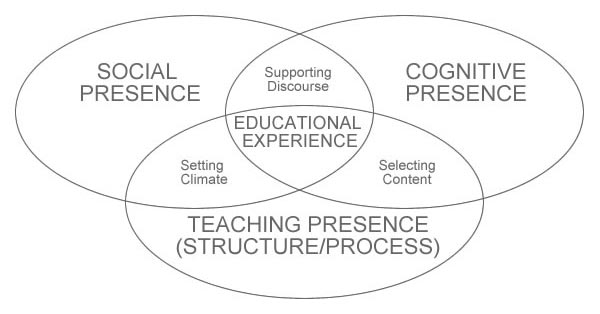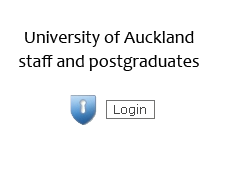How can I engage my students in learning?
Getting started
 Orientation
Orientation
- What does it mean to engage students in learning?
- What models exist to guide planning to engage students effectively?
- What challenges need to be overcome to engage students in learning?
This section provides one model - the Community of Inquiry Model - for understanding how to engage students in learning. Our aim in presenting this model is to provide you with a basic understanding of the subject area that will enable you to reflect on how you engage your own students. Your reflections can provide you with a starting point for exploring other relevant sections of this resource.
Community of Inquiry
Engaging students has to do with holding their attention and focusing them on their learning. One way to achieve this is to create the conditions for an effective community of inquiry (see Rourke et al and Hutchins in Taking it Further).

In this model, learning is facilitated through the interaction of three types of presence:
Students are cognitively present to the extent that they are actively engaged in critical thinking about content through their interactions with the learning materials and/or with one another and/or and/or with the educator;
Teachers are present as subject matter experts, through their planning, and through the supports that they provide for students e.g. feedback on assignments, marking rubrics;
Participants (teachers and learners) are socially present to the extent that they project themselves socially and emotionally in a community of inquiry to support cognitive aims (e.g. instigating and supporting critical thinking) and to support affective aims (motivating, supporting, rewarding, encouraging).
If we think about the community of inquiry model we can see that there are various ways that students might be engaged in learning. You might find it useful to take a look at the work of Covington (2000) to see how Covington's idea of Mastery Learning fits into the model of three types of presence.
Covington posed some useful ideas for the medical learning environment. He argued that education strategies need to emphasise mastery learning rather than focussing on performance. Ways to develop mastery learning can include encouraging self-determination, autonomy, self-defined goal setting, and student participation. It is also important to reward improvements in learning either through considered feedback or other appropriate methods.
 Reflection
Reflection
How might you connect the community of inquiry model with your own teaching?
Do you currently engage your students using a strategy that facilitates cognitive, social and teaching presence? If not, could you work on student engagement through increasing your teaching presence or through providing learning activities to increase the level of students' cognitive engagement?
Take a look at the Alison King article in the Taking it Further section if you want some ideas on teaching activities that can actively engage students in collaborative learning.
Engaging Your Students
Ideally, your students will be engaged throughout the course that you are teaching. Engaging your students at this level requires careful design and planning of courses and programmes. You will also want your students to be actively engaged with all the aspects of the particular learning activities that you plan for them. This means that you need to deliver teaching to facilitate learning.
Tony Fernando talks about the strategies he uses to engage with his students:
![]() Click to view the video (requires Flash Player).
Click to view the video (requires Flash Player).
Students are diverse in terms of their backgrounds and their learning styles (amongst other things) and engaging all students in learning means taking diversity into account.
 Action
Action
If you can show that you are engaging your students in learning then you will have gone some way towards evidencing an overall satisfactory teaching performance.
- Consider your own teaching. Are there particular areas of your teaching where you would like to work on student engagement?
- If you identify a particular course or a particular part of the course where you can work on student engagement, you might want to start by making a note of the challenges and/or opportunities that present themselves.
- Once you have made a note of the challenges you might want to start a record in myEPORTFOLIO to document the challenge along with the actions that you are going to take to meet that challenge.
Taking it further
The purpose of this review is to document the directions and recent progress in our understanding of the motivational dynamics of school achievement. Based on the accumulating research it is concluded that the quality of student learning as well as the will to continue learning depends closely on an interaction between the kinds of social and academic goals students bring to the classroom, the motivating properties of these goals and prevailing classroom reward structures. Implications for school reform that follow uniquely from a motivational and goal-theory perspective are also explored.

| Hutchins, H. (2003). Instructional Immediacy and the Seven Principles: Strategies for Facilitating Online Courses. Online Journal of Distance Learning Administration, 6(3). |
This article draws on the Rourke article (see below) to discuss effective instructor presence for online teaching. Although the article deals with online teaching, the ideas will be useful for face-to-face teaching. However, we would recommend reading Rourke's original article for an understanding of the community of inquiry model.
| King, Alison. (1993). From Sage on the Stage to Guide on the Side. College Teaching, 41(1), 30-35. |
This article was published some time ago but it introduces the now widely accepted distinction between the "sage of the stage" and the "guide on the side". The sage on the stage transmits information to passive recipients whilst the guide on the side uses active learning techniques to engage students in the learning process. Note that lecturing can be a teaching method that actively engages students in learning. For example, personal response systems of "clickers" can be used in a lecture to engage and interact with students.
The twenty-first century demands not only that we learn new forms of social engagement but also that we unlearn habits that have been useful in the past but may no longer be valuable to the future. Teachers have 'un-learned' the role of Sage-on-the-stage as the dominent model of teaching, and the shift to Guide-on-the-side has served an important function in changing the focus of pedagogy from the teacher to the learner. However, Guide-on-the-side is no longer sufficient for our times. This paper argues the importance of a further shift to Meddler-in-the-middle. Meddler-in-the middle positions the teacher and student as mutually involved in assembling and dis-assembling cultural products. It re-positions teacher and student as co-directors and co-editors of their social world. Meddler-in-the-middle challenges more long-term notions of 'good' teaching in a number of ways. Specifically, it means: (1) less time giving instructions and more time spent being a usefully ignorant co-worker in the thick of the action; (2) less time spent being a custodial risk minimiser and more time spent being an experimenter and risk-taker; (3) less time spent being a forensic classroom auditor and more time spent being a designer, editor and assembler; (4) less time spent being a counsellor and 'best buddy' and more time spent being a collaborative critic and authentic evaluator.
| Rourke, L., Anderson, T., Archer, W., & Garrison, D. R. (1999). Assessing Social Presence in Asynchronous, Text-Based Computer Conferences. Journal of Distance Education, 14(2), 51-70 |
This article discusses computer conferencing in higher education, presents a community of inquiry model and discusses social presence, defined as the ability of learners to project themselves socially and affectively into a community of inquiry. The theory is applicable beyond computer conferencing.
Add to myEportfolio
| If you need to log in: FMHS staff - log in with NetID/UPI. Registration is not required. Affiliated members, e.g. clinical teachers who don't have NetID, can register for an account after clicking 'Login'. | ||||
 |  | |||
 How can I engage my students in learning?
How can I engage my students in learning?
“A teaching philosophy can help you to reflect on how and why you teach. If you don’t have a teaching philosophy, you might want to consider writing one. You can take a look at What makes a good teacher? to get started. If you already have a teaching philosophy, you might want to reflect on how the work that you are doing here fits with that philosophy”.




